The post Survivors of Malmedy appeared first on World War Media.
]]>On December 17, 1944, during the Battle of the Bulge, more than eighty unarmed American soldiers were shot down after having surrendered to an SS tank column near the small crossroads town of Malmédy, Belgium.
The delightful Belgian town of Malmédy will forever be associated with the most infamous massacre of American troops in World War II. And yet, but for the presence of an Associated Press correspondent there in early January 1945, it is doubtful that this terrible incident would have ever achieved international notoriety. ‘Nazis Turned Machine Guns on GI POWs wrote Hal Boyle in his January 1945 Stars and Stripes article, and from that first graphic account sprung a plethora of books and articles about the so-called Malmédy Massacre. Few of these accounts are based on facts.
It is unlikely that we shall ever know the precise sequence of events at the Baugnez crossroads, near Malmédy, on December 17, 1944, or the reasons for them. The secret lies with the guilty and the dead. Nevertheless, many corroborated facts are known and a careful analysis of these facts can bring us closer to the truth of what happened.
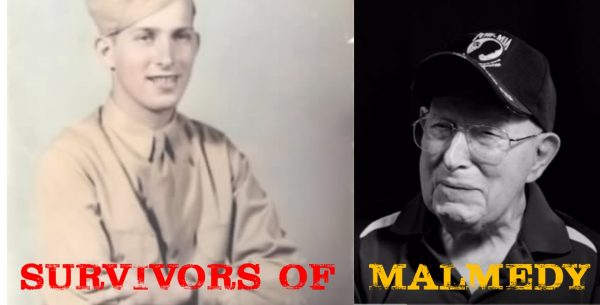
In this film, Emmy Award winning director/producer Tim Gray introduces you to the last survivors of the massacre. Bringing you back to the actual scene, it tells the story as seen through their eyes, their memories of how they escaped execution by the 1st SS Leibstandarte Adolph Hitler.
A moving story, very well documented.
Broadcasted on PBS in the spring of 2018
The post Survivors of Malmedy appeared first on World War Media.
]]>The post A 360° stroll at the Hürtgen Forest appeared first on World War Media.
]]>Dutch Photographer, videographer and image-artist Marcel takes you on a short walk into the Hurtgen Forest. By using the cursor you can experience what it is like being down in one of the many bunkers.
By September 1944, the Allied offensive in Western Europe had swept from the Normandy beaches all the way to the West Wall, or Siegfried Line, the formidable defensive position along the German border consisting of concrete bunkers fronted by antitank obstacles. Anxious to move quickly through the West Wall, Major General J. Lawton Collins, commander of the First Army’s VII Corps, plotted an advance south and east of Aachen through a 70-square-mile section of heavily wooded terrain known as the Hürtgen Forest.
Within the Hürtgen lay several massive dams that managed the flow of the Roer River and its tributaries. Rather than the useless real estate of the forest, the flood-controlling dams were genuine strategic assets, but the American planners initially ignored their value and drew up no plans to secure them. Their strategy was fixed upon crossing the Roer and seizing the city of Düren.
Originally intended to put pressure on German forces to keep them from reinforcing Aachen to the north, the Allied assault into the Hürtgen Forest was also dubiously intended to enable the Army to zero in on the industrial centers of the Ruhr Valley. Initial American thrusts during the first phase in late September and early October centered on the village of Schmidt, which U.S. forces attempted to access via the narrow and treacherous Kall Trail.
Terrain in the area was incredibly rough, however, and resupply and armor support severely restricted. Dotted with German minefields, snipers, and rocked by intense artillery bombardments, the forest was also a deathtrap for the advancing troops. Within the first three weeks of fighting, casualties were appalling at over 4,500 American troops killed and wounded — and for the cost, very little ground was gained.

The post A 360° stroll at the Hürtgen Forest appeared first on World War Media.
]]>The post The P-47 Crash at Bastogne appeared first on World War Media.
]]>During the Battle for Bastogne, on December 30 1944, P-47 fighter pilot Harry Krigg made an emergency exit out of his aircraft and landed leg broken in no-mans-land.
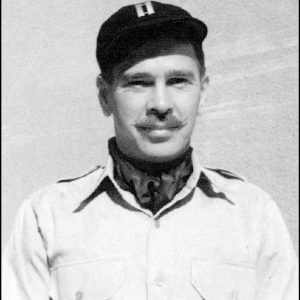
Shortly after Harry hit the snowy ground, 3rd Bn 506 PIR 101 Abn Medic Johnny Gibson managed to pull him into safety.
In this video, WWII historian Reg Jans tells the story.
The post The P-47 Crash at Bastogne appeared first on World War Media.
]]>The post U.S. Mortars of World War II appeared first on World War Media.
]]>
When history is visceral and experiential, it is typically more compelling and engaging than when it is taken out of the human context. The subject is notorious for being presented in dry and uninteresting ways, but that is mainly because most people are exposed almost exclusively to the sterility of classroom lecture. When it comes to the history of the Second World War, classroom instruction is critical to understanding the big picture of the conflict, but bringing clarity to the individual soldier experience is something that is typically best edified by good old-fashioned fieldwork.
by Martin K.A. Morgan and very special thanks to Brian Domitrovich
This can be done by visiting a battlefield or, in some countries, by live-firing the weapons used in a given war. As described in my January 22, 2017 post about shooting the German MG.42 machine gun, a day at the range can offer a powerful and memorable insight into the lives of those who experienced combat first hand. But even in the U.S.A. where it is possible to own just about every type of weapon used in ground combat between 1939 and 1945, one category is usually missing: mortars. Each country involved in World War II used them to great effect in circumstances where indirect, high-angle fire was needed but field artillery fire was unavailable. They were dangerously accurate, and they could operate in rain or shine – in the blistering heat or the numbing cold.
Despite their prolific use and significant importance to the story of World War II combat, most American collectors do not own mortars, and as a result they are largely only understood in the abstract. We read technical details about weight, range, accuracy and explosive power, but we just do not have access to them like we have access to rifles, pistols and machine guns. For that reason, I recently traveled to western Pennsylvania for a day at the range with Brian Domitrovich, owner of three live U.S. World War II mortars: a 60mm, an 81mm and a 4.2-inch. Brian’s possession of these weapons is regulated by the National Firearms Act of 1934, which designates them as “destructive devices” and holds him up to stringent qualifications for their ownership.
For him to be eligible to purchase these registered destructive devices, Brian had to be a U.S. citizen over the age of 21 with no criminal arrest record, he was required to pay a one-time $200 transfer tax for each weapon, and he had to wait between six and twelve months while each transfer application was reviewed by the Bureau of Alcohol, Tobacco, Firearms and Explosives (the “BATFE”). In other words, the 1934 National Firearms Act created a heavily regulated category of civilian ownership that Brian qualified for, thus allowing him to make it rain 60mm, 81mm and 4.2-inch mortar rounds. We hauled all three weapons out to the Beaver Valley Rifle and Pistol Club near the township of Patterson Heights, Pennsylvania and spent the day putting each tube through its paces.
For each mortar, we fired only inert projectiles – meaning that only propelling charges were used and none of what we fired exploded downrange. The only partial exception was the M2 mortar, through which we fired BATFE-approved 60mm reusable training projectiles made exclusively by ordnance.com. These projectiles are equipped with a proprietary fuze assembly that produces a non-lethal impact explosion through the use of a point-detonated 20-guage blank shotgun shell. Although they do not distribute deadly fragments, they do produce a report downrange that simulates the experience of shooting a 60mm M49A2 high explosive round.
The smallest and lightest of the three mortars being demonstrated that day, the M2, consists of a 12.8-pound tube, a 16.4-pound bi-pod/mount, and a 12.8-pound baseplate. With an overall 42-pound weight, the M2 gave U.S. fighting forces during the Second World War the kind of handy mobility that made it easy to provide company-level fire support, and even advance with an attacking echelon if necessary. Although it can deliver concentrations of fire to a maximum range of 2,000 yards, we had to keep our rounds within 200 yards so as not to lose any of the five-pound reusable training projectiles. When we went downrange to recover the rounds, they were all sticking out of the ground like lawn darts within a few feet of each other.
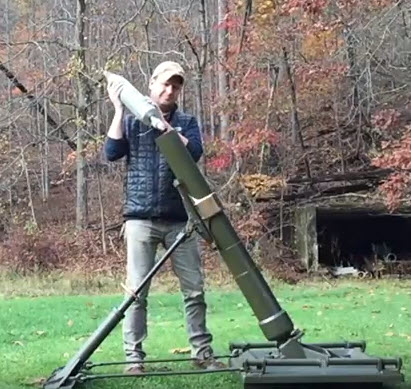
Moving up in size and weight, we fired the 81 mm M1 mortar next, but the space constraints at Beaver Valley Rifle and Pistol Club prevented us from realizing that weapon’s full range potential. With a full increment charge and a 6.87-pound M43A2 high explosive round, the M1 mortar could hit a target almost 3,300 yards away, giving it a significant range advantage over the 60mm M2 mortar. Using a minimum propellant charge, we were able to keep all of our 8-pound, 81 mm projectiles in one area but they still dug deeper into the ground than the lighter 60mm projectiles did. The M1’s greater capabilities come with a cost though: greater weight. With a 44.5-pound tube, a 46.5-pound mount, and a 45-pound base plate, the total package is almost 100-pounds heavier than the 60mm mortar.
Despite its weight though, the 81mm mortar was an important part of the Table of Organization and Equipment of U.S. Army and U.S. Marine Corps maneuver battalions throughout World War II. It was even a tool used by airborne units, and was dropped in parachute bundles during Operations Neptune, Market Garden, and Varsity. Ground combat units appreciated the 81mm mortar because of its mobile and hard-hitting qualities, and that is why it occupied a prominent place in the arsenal of American fighting forces during the Second World War.
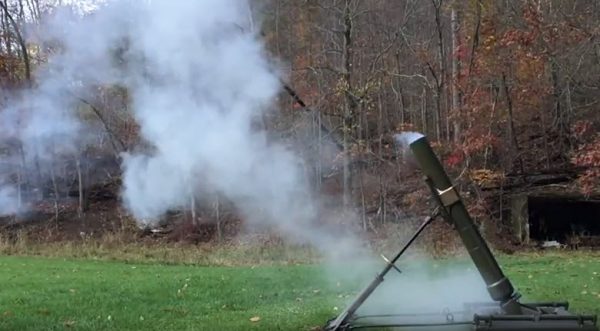
Last but not least, we fired the mighty 4.2-inch M2 chemical mortar. Developed before World War II as a means of delivering toxic agents (thus the name “chemical mortar”), the U.S. Army Chemical Weapons Service eventually turned the 4.2 into a weapon capable of delivering high-explosive fire. But TNT, and Mustard Gas rounds were not on the menu for our live fire exercise, so M335A2 Illuminating Rounds were used instead. Weighing 17-pounds each, they tumbled through the air like parabolic watermelons and half-buried themselves in the mud at the very edge of the designated long-range lane. While convenient for our purposes, the M335A2 rounds need the weight of the illuminating chemicals in them to stabilize in flight. The ones we fired that day were inert and (therefore) empty, so there was only so much the barrel could do.
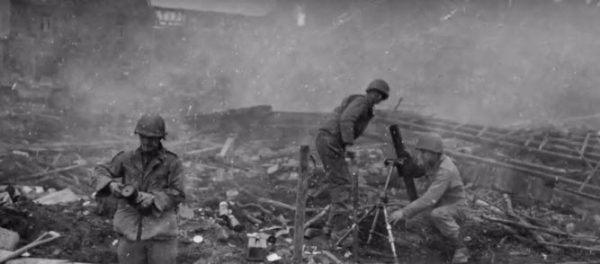
Unlike the 60mm and the 81mm mortars, the “four deuce” uses a rifled barrel to stabilize its projectiles in flight, and those projectiles engage that rifling through the use of a brass obturating plate. While the barrel did its job with no problem and the rounds caught the rifling as they were designed to, after leaving the tube’s muzzle at 700 feet per second they gradually lost their stability and started to tumble. Still, it was lots of fun throwing them skyward in an offering to the spirit of Saint Barbara. Once again though, we had to generate as little range as possible, which was not an insignificant challenge with the “four deuce.” That weapon can throw a round out to 4,400 yards (2.5 miles) and we had only 300 yards to play with, so we were barely scratching the surface of what that tube could do.
Weighing-in at 333-pounds overall, the “four deuce” is a beast of a weapon. Just to put this in perspective, it weighs the same as eight 60mm mortars or two and a half 81mm mortars. It’s base plate alone weighs as much as I do, which only became an issue when we had to carry it up the stairs from Brian’s basement to get it to his truck. Every bit of that effort was worthwhile though because it offered a priceless opportunity to appreciate the difficulty of manhandling this weapon that contributed so meaningfully to allied victory in World War II. The 4.2-inch mortar fought for the first time in the Sicily campaign in 1943 during which it fired over 35,000 rounds in 38-days. It then went-on to fight it’s way across difficult terrain in Europe and islands in the Pacific.
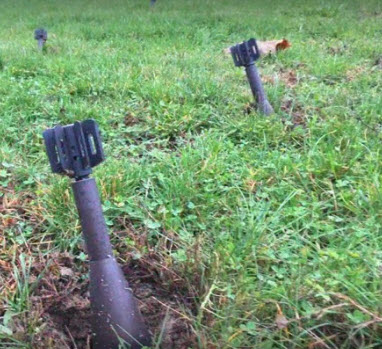
The Army used it, the Marine Corps used it, and even the U.S. Navy used it on landing craft converted into mortar gunboats under the designation LCI(M). Though it never delivered a gas attack in combat, it did put down vast quantities of TNT and smoke during World War II and again during the war in Korea. Having the chance to shoot the “four deuce” – alongside its 60 mm and 81 mm cousins – provided the kind of visceral and tactile experience that I value because it helps bring another element of the story of World War II into sharper focus.
The post U.S. Mortars of World War II appeared first on World War Media.
]]>The post Journey Home to the USS Arizona appeared first on World War Media.
]]>Ray Haerry, Sr. passed away in September of 2016. In April of 2017, the Haerry family had their father/grandfather’s ashes interred on the Arizona so he can once again be with the over 1,000 shipmates who lost their lives on December 7, 1941 when Pearl Harbor was attacked plunging America into World War II.
The mission of the non-profit World War II Foundation is to produce educational films and create initiatives recognizing the bravery and enormous contributions made by the veterans and survivors of World War II so that future generations appreciate the determination and sacrifices that enabled perpetuation of our basic freedoms.
For this film, premiering on Saturday November 4 at Jane Pickens Theater & Events Center, Newport, RI, the Foundation follows the family of USS Arizona survivor Raymond Haerry as they return to Pearl Harbor to place their father’s ashes back aboard the great battleship.
The remains of more than 900 sailors killed that day aboard the Arizona remain inside. Of the 334 who survived, 41 have asked over the years to rejoin their fellow sailors upon their death.
“I believe this is the most impactful film of 19 we have done to date due to the message it delivers, which is that people still remember and care about what that generation contributed and suffered through to save the world.” Tim Gray, Chairman of of the WWII Foundation, says.
“It’s an unspoken bond these guys had with each other, these were Ray Haerry’s brothers. And the Arizona was their home.”.
The hour-long documentary, narrated by actor Matthew Broderick, will air nationally on American Public Television in the fall of 2017.
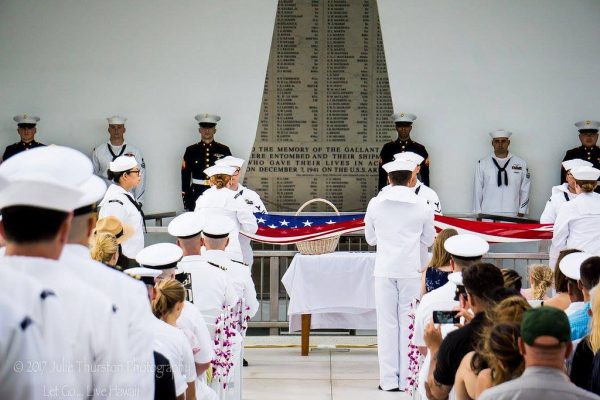

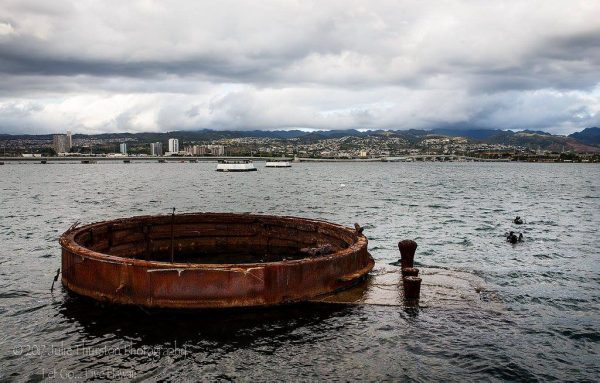
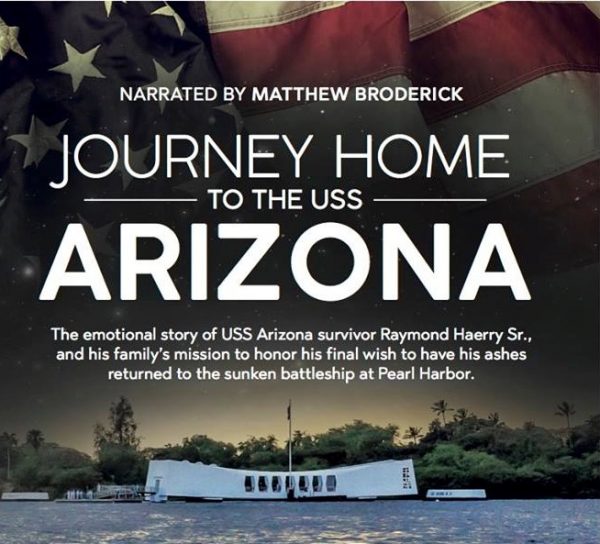
The post Journey Home to the USS Arizona appeared first on World War Media.
]]>The post Lost WWI Submarine Discovered Near Belgian Coast appeared first on World War Media.
]]>Researchers have located the wreck of a World War I German U-boat off the coast of Belgium. The submarine, which sank more than 100 years ago, was part of a campaign to harass Allied shipping. The submarine may be one that was reportedly sunk by a mine but whose wreck was never found.
Found somewhere between 82-98 feet under the surface, the boat is reportedly 88 feet long and nearly 20 feet wide. WWI U-boats were commonly staffed by a crew of 23 and, given the ship’s preserved condition, officials believe it’s likely the crew is still inside.
In an interview with LiveScience, marine archaeologist Tomas Termote, one of the divers who discovered the ship, said sonar scans first picked up presence of a large, wrecked object on the seafloor in 2014. He initially thought the wreckage came from the remains of a World War II landing craft, which have been frequently found in the area.
Video taken of the wreckage shows the top of the ship’s remains. In the hundred years since it sank, barnacles and algae have since grown over the structure.
It’s the 11th such sunken German ship to have been discovered in the region and reportedly in the best condition. The submarine was a UB-II type of U-boat, a formidable weapon of war in their heyday. Equipped with torpedoes, UB-IIs were frequently stationed in the North Sea and unleashed significant damage on allied forces.
The post Lost WWI Submarine Discovered Near Belgian Coast appeared first on World War Media.
]]>The post D-Day Historian: A James Bond Story appeared first on World War Media.
]]>In this short video, D-Day Historian and recognized author Paul Woodadge talks at the War Cemetary in Bayeux, Normandy
Ian Lancaster Fleming (28 May 1908 – 12 August 1964) was an English author, journalist and naval intelligence officer who is best known for his James Bond series of spy novels. Fleming came from a wealthy family connected to the merchant bank Robert Fleming & Co., and his father was the Member of Parliament for Henley from 1910 until his death on the Western Front in 1917. Educated at Eton, Sandhurst and, briefly, the universities of Munich and Geneva, Fleming moved through several jobs before he started writing.
While working for Britain’s Naval Intelligence Division during the Second World War, Fleming was involved in planning Operation Goldeneye and in the planning and oversight of two intelligence units, 30 Assault Unit and T-Force. His wartime service and his career as a journalist provided much of the background, detail and depth of the James Bond novels.
Fleming wrote his first Bond novel, Casino Royale, in 1952. It was a success, with three print runs being commissioned to cope with the demand. Eleven Bond novels and two collections of short-stories followed between 1953 and 1966. The novels revolved around James Bond, an officer in the Secret Intelligence Service, commonly known as MI6. Bond was also known by his code number, 007, and was a commander in the Royal Naval Reserve.
Paul Woodadge is a British born battlefield guide and historian living in Normandy, France. He is a published author and in addition to working as a DDay and Battle of Normandy tour guide he works as a historical consultant and advisor on WWII documentaries, films and TV shows. He is highly regarded as one of the foremost experts on 1944 and the invasion of Europe by the Allies and has met countless veterans.
The post D-Day Historian: A James Bond Story appeared first on World War Media.
]]>The post D-Day Historian: Carwood Lipton in Normandy appeared first on World War Media.
]]>In this short video historian and author Paul Woodadge talks about Sgt Carwood Lipton’s landing in Normandy on D-Day.
First Lieutenant Clifford Carwood Lipton (30 January 1920 – 16 December 2001) was a commissioned officer with Easy Company, 2nd Battalion, 506th Parachute Infantry Regiment, in the 101st Airborne Division during World War II. Lipton was portrayed by Donnie Wahlberg in the HBO miniseries Band of Brothers. On the battlefields of Europe, he was promoted to Company First Sergeant and ultimately was awarded a battlefield commission to Second Lieutenant. He said “it was the greatest honor ever awarded” to him. He eventually earned a promotion to First Lieutenant before leaving the Army.
Paul Woodadge is a British born battlefield guide and historian living in Normandy, France. He is a published author and in addition to working as a DDay and Battle of Normandy tour guide he works as a historical consultant and advisor on WWII documentaries, films and TV shows. He is highly regarded as one of the foremost experts on 1944 and the invasion of Europe by the Allies and has met countless veterans.
The post D-Day Historian: Carwood Lipton in Normandy appeared first on World War Media.
]]>The post Honoring D-Day Veterans appeared first on World War Media.
]]>On June 6, 2017, at the Normandy town of Arromanches-Les-Bains, British WWII veterans receive a heart-warming and well-deserved welcome from the crowd. Most of the veterans came ashore on Juno, Sword or Gold Beach on or around D-Day, seventy-three years ago.
Arromanches-les-Bains
Arromanches is remembered as a historic place of the Normandy landings and in particular as the place where an artificial port was installed. This artificial port allowed the disembarkation of 9,000 tons of material per day.
It was on the beach of Arromanches that, during the Invasion of Normandy immediately after D-Day, the Allies established an artificial temporary harbour to allow the unloading of heavy equipment without waiting for the conquest of deep water ports such as Le Havre or Cherbourg. Although at the centre of the Gold Beach landing zone, Arromanches was spared the brunt of the fighting on D-Day so the installation and operation of the port could proceed as quickly as possible without damaging the beach and destroying surrounding lines of communication. The port was commissioned on 14 June 1944.
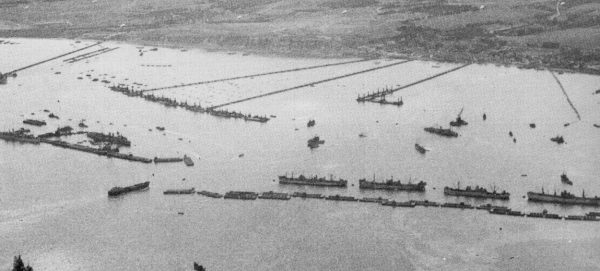
This location was one of two sites chosen to establish the necessary port facilities to unload quantities of supplies and troops needed for the invasion during June 1944, the other was built further West at Omaha Beach. The British built huge floating concrete caissons which, after being towed from England, then had to be assembled to form walls and piers forming and defining the artificial port called the Mulberry harbour. These comprised pontoons linked to the land by floating roadways. One of these ports was assembled at Arromanches and even today sections of the Mulberry harbour still remain with huge concrete blocks sitting on the sand and more can be seen further out at sea.
Some key figures: by 12 June 1944 more than 300,000 men, 54,000 vehicles, 104,000 tons of supplies had been landed. During 100 days of operation of the port 2.5 million men, 500,000 vehicles, and 4 million tons of material were landed. The best performance of the port was in the last week of July 1944: during those seven days the traffic through Arromanches exceeded 136,000 tons or 20,000 tons per day.
The post Honoring D-Day Veterans appeared first on World War Media.
]]>The post Historian Alex Kershaw Talks About the Most Decorated Platoon in WWII appeared first on World War Media.
]]>On a cold morning in December, 1944, deep in the Ardennes forest, a platoon of eighteen men under the command of twenty-year-old lieutenant Lyle Bouck were huddled in their foxholes trying desperately to keep warm. Suddenly, the early morning silence was broken by the roar of a huge artillery bombardment and the dreadful sound of approaching tanks. Hitler had launched his bold and risky offensive against the Allies-his “last gamble”-and the small American Intelligence and Reconnaissance platoon of the 394 Regiment, 99 Infantry Division, was facing the provisional vanguard of the 1 SS Leibstandarte Adolph Hitler.
Vastly outnumbered, they repulsed three German assaults in a fierce day-long battle, killing over 64 German Fallschirmjaeger and wounding another 100, defending a strategically vital hill. Only when Bouck’s men had run out of ammunition did they surrender to the enemy. As POWs, Bouck’s platoon began an ordeal far worse than combat-survive in captivity under trigger-happy German guards, Allied bombing raids, and a daily ration of only thin soup. In German POW camps, hundreds of captured Americans were either killed or died of disease, and most lost all hope. But the men of Bouck’s platoon survived-miraculously, all of them. Once again in vivid, dramatic prose, Alex Kershaw brings to life the story of some of America’s little-known heroes-the story of America’s most decorated small unit, an epic story of courage and survival in World War II, and one of the most inspiring stories in American history.
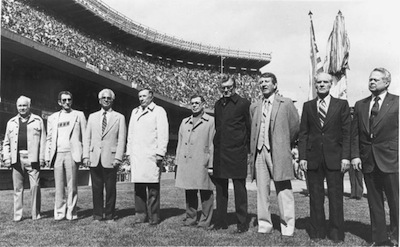
The I&R Platoon’s first reunion
In this short video, historian and author Alex Kershaw returns to Lanzerath, Belgium and talks about the I&R Platoon.
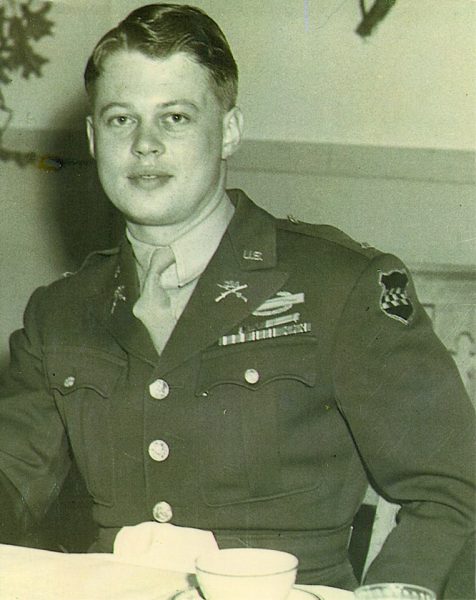
The post Historian Alex Kershaw Talks About the Most Decorated Platoon in WWII appeared first on World War Media.
]]>The post The Modified M3 Grease Gun in WWII appeared first on World War Media.
]]>
The .45 caliber submachine gun M3 is often indicated as being a success story of small arms design and development during World War II. Born of the necessities and exigencies of a full national wartime mobilization, it is best known for the economy of scale it provided and the modesty of its manufacturing costs.
by Martin K A Morgan
At peak production, M3s were a bargain at $20.94 each – that’s less than half the cost of the cheaper, mass-production version of the Thompson submachine gun. Although low cost was a major factor in the M3’s success, so too was the speed of its development and adoption. The project went from a concept on paper, to the T20 prototype, to adoption and production within just seven months, a record that no other firearm in U.S. military history has ever challenged. When it went into production in May 1943 at GM’s Guide Lamp Division plant in Anderson, Indiana, the M3 was a reliable open-bolt submachine gun weighing just over eight pounds with a fully loaded 30-round detachable box magazine. It’s design made extensive use of sheet metal stampings to include the two halves of the receiver assembly, the trigger, the rear sight, and a crank handle on the right side of the gun used to retract the bolt before firing. The M3’s sheet metal construction made it lighter and cheaper to produce, and gave it an appearance resembling an auto mechanics grease gun. But sheet stampings also created one weakness that would soon reveal itself on the battlefield.
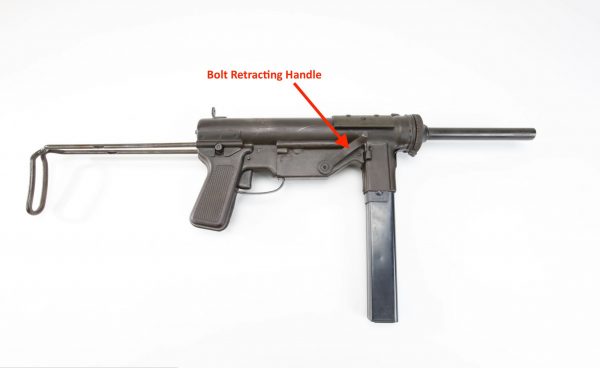
A right side view of M3 submachine gun #0061260 – an early pattern Grease Gun produced at GM’s Guide Lamp Division plant in Anderson, Indiana in 1943. The red arrow shows the delicate bolt retracting “crank handle” that created the need for a field modification. (Photo courtesy of the National Firearms Museum)
On Tuesday, June 6, 1944, U.S. troops used the M3 Grease Gun in action for the first time. During the weeks that followed, it fought a vigorous campaign stretching from Normandy through to the liberation of Paris and the push to the Siegfried Line. Soldiers carried it up hill and down valley through the adversity of dust, rain and, eventually, even the snow. They were beat-up as the troops climbed on and off of trucks, half-tracks, and tanks. While an M3 could survive being dropped on its left side without affecting its ability to function, dropping one on its right side was another matter entirely because that is where the weapon’s fragile sheet metal retracting handle was mounted to the trigger housing assembly.
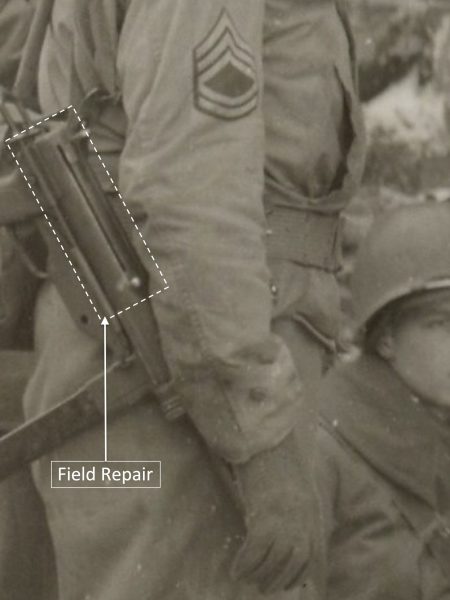
An officer in the headquarters of the 253rd Armored Field Artillery Battalion/6th Armored Division reads the “Articles of War” to his men on January 20, 1945 in the village of Mageret, Belgium three miles east of Bastogne. Note the Sergeant First Class at far left is armed with a field modified M3 submachine gun. (Official U.S. Army photograph)
On numerous occasions during the closing months of 1944, U.S. Army soldiers dropped M3 Grease Guns in such a way that they broke off crank handles. With no retracting mechanism, the bolt could not be drawn to the rear and, the weapon could not be used. At the time, the Army’s ordnance companies were ready to repair just about any infantry weapon in inventory, but not the brand new Grease Gun. In the rush to develop and the adopt the weapon, the potential for breakage of the inherently vulnerable crank handle was overlooked with the result that, when it finally began to happen in France after the D-Day, there was no prescribed method of repairing the problem and, more importantly, no spare parts. This meant that repairmen had to improvise and make due with what they had on hand.
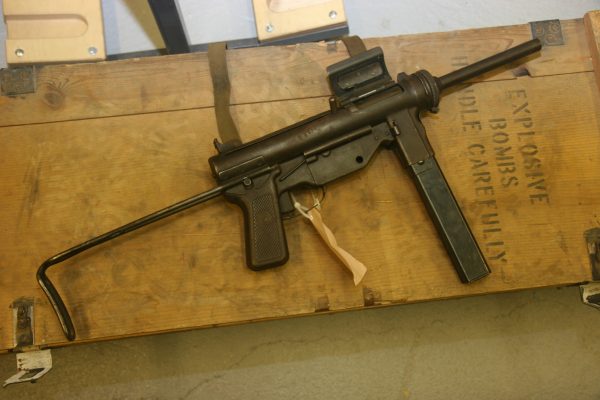
A field modified M3 submachine gun in the collection of Musée National d’Histoire Militaire (the National Military History Museum) in Diekirch, Luxembourg. The weapon’s crank handle has been removed, a slot has been cut in the receiver and a makeshift cocking handle has been added to the bolt.
The solution was straightforward and simple: ordnance company personnel started by removing what was left of the retracting handle assembly from each damaged weapon, then used an end mill to cut a seven-inch long slot into the right hand side of the receiver at the 2 o’clock position running from just behind the weapon’s ejection port. This accommodated a crudely hewn steel bolt handle that inserted through an enlarged opening at the forward end of the slot and entered a hole drilled into the back end of the bolt assembly. It was not a pretty repair, but it worked. A few archival photographs of men from General George Patton’s Third Army taken around the time of the Battle of the Bulge show Grease Guns repaired in this manner. In addition to that, the collection of Musée National d’Histoire Militaire (the National Military History Museum) in Diekirch, Luxembourg has in its collection five M3s that have received this field modification. Considering the fact that the Third Army operated in Luxembourg during and after the Battle of the Bulge, it looks like this field modification may have been confined to the ranks of that specific unit. Interestingly enough though, a product improvement was already in development back in the USA that would make this design shortcoming superfluous.
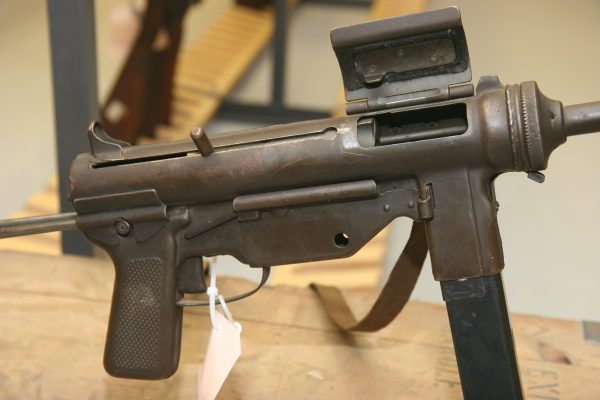
A field modified M3 submachine gun in the collection of Musée National d’Histoire Militaire (the National Military History Museum) in Diekirch, Luxembourg. The weapon’s crank handle has been removed, a slot has been cut in the receiver and a makeshift cocking handle has been added to the bolt.
As early as April 1944, Guide Lamp was working on the modified M3E1 submachine gun. In addition to a number of other design refinements, it featured the complete elimination of the M3’s crank handle assembly and its replacement with a simplified, and indestructible, finger hole in the bolt. The substantial weight of the M3’s bolt was such that the pressure exerted by the weapon’s dual mainsprings was only eighteen-pounds. This meant that the old crank handle apparatus was not just unnecessarily complex, it was unnecessary altogether because the physical effort of retracting the bolt could be managed comfortably by the shooter’s index finger alone. No lever device necessary. On December 21, 1944, the M3E1 was officially adopted as the .45-caliber submachine gun, M3A1 – coincidentally at the same time that field modified M3s were fighting the German onslaught 4,000 miles away in the Ardennes Forrest. Although the fragile crank handle issue was fully resolved with the introduction of the M3A1, the crude and yet perfectly functional field modification that it produced nevertheless says something complimentary about ordnance technicians during World War II. When confronted with a significant repair job on a new weapon with no replacement parts available, they had to adapt, adjust and overcome, and they had to do it quickly. It is a testament to the skill and know-how of these Army gunsmiths that they came up with a practical solution under less than ideal circumstances.
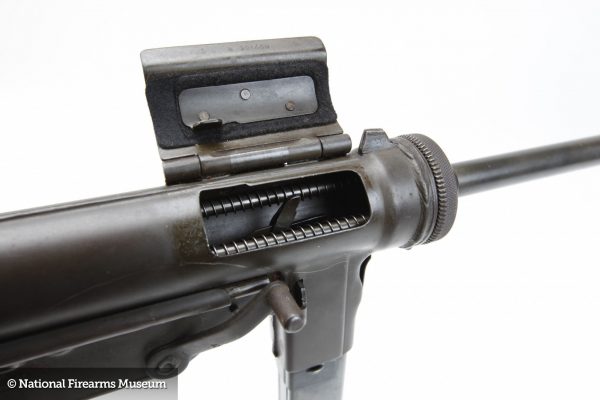
A close-up view of M3 submachine gun #0061260 showing its bolt retracting “crank handle” and ejection port. (Photo courtesy of the National Firearms Museum)
The post The Modified M3 Grease Gun in WWII appeared first on World War Media.
]]>The post 80 Years Ago: The Hindenburg Disaster appeared first on World War Media.
]]>Original footage from the British Pathe archive shows impressive shots of the LZ 129 ‘Hindenburg’ flying overhead and crashing on its landing ground at Lakehurst NJ, on ThursdayMay 6, 1937.
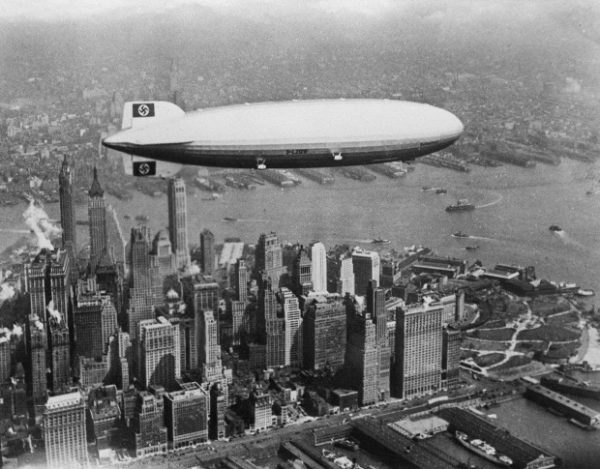
The disaster killed 35 persons on the airship, and one member of the ground crew, but miraculously 62 of the 97 passengers and crew survived.
After more than 30 years of passenger travel on commercial zeppelins — in which tens of thousands of passengers flew over a million miles, on more than 2,000 flights, without a single injury — the era of the passenger airship came to an end in a few fiery minutes.
Actual construction of LZ-129 began in the Fall of 1931, but progress lagged due to a severe lack of funds during the Depression. At first, the Nazi Party’s assumption of power in January, 1933 had little effect on the fortunes of the Zeppelin Company, partly due to Air Minister Hermann Göring’s dislike of lighter-than-air flight. But Propaganda Minister Joseph Goebbels was aware of the potential symbolic value of LZ-129 as a showcase for German strength and technology, and in 1934 Goebbels offered Hugo Eckener 2 million marks toward the completion of LZ-129.
Nazi officials were very much aware of the symbolic value of the huge and impressive airship, and frequently called on Hindenburg for propaganda flights, often in company with the Graf Zeppelin.
Hindenburg made appearances at public events such as the 1936 Berlin Games and the Nuremberg Party rally, and Hindenburg’s first major flight, after test flights were completed, was a 74-hour propaganda flight in support of Hitler’s remilitarization of the Rhineland.
The Disaster
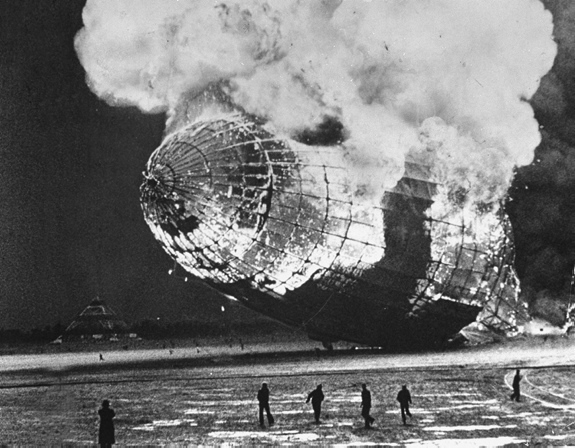
At 7:25 p.m. local time, the Hindenburg caught fire and quickly became engulfed in flames. Eyewitness statements disagree as to where the fire initially broke out; several witnesses on the port side saw yellow-red flames first jump forward of the top fin near the ventilation shaft of cells 4 and 5. Other witnesses on the port side noted the fire actually began just ahead of the horizontal port fin, only then followed by flames in front of the upper fin. One, with views of the starboard side, saw flames beginning lower and farther aft, near cell 1 behind the rudders. Inside the airship, helmsman Helmut Lau, who was stationed in the lower fin, testified hearing a muffled detonation and looked up to see a bright reflection on the front bulkhead of gas cell 4, which “suddenly disappeared by the heat”. As other gas cells started to catch fire, the fire spread more to the starboard side and the ship dropped rapidly. Although there were cameramen from four newsreel teams and at least one spectator known to be filming the landing, as well as numerous photographers at the scene, no known footage or photograph exists of the moment the fire started.
Wherever they started, the flames quickly spread forward first consuming cells 1 to 9, and the rear end of the structure imploded. Almost instantly, two tanks (it is disputed whether they contained water or fuel) burst out of the hull as a result of the shock of the blast. Buoyancy was lost on the stern of the ship, and the bow lurched upwards while the ship’s back broke; the falling stern stayed in trim.
As the tail of the Hindenburg crashed into the ground, a burst of flame came out of the nose, killing nine of the 12 crew members in the bow. There was still gas in the bow section of the ship, so it continued to point upward as the stern collapsed down. The cell behind the passenger decks ignited as the side collapsed inward, and the scarlet lettering reading “Hindenburg” was erased by flames as the bow descended. The airship’s gondola wheel touched the ground, causing the bow to bounce up slightly as one final gas cell burned away. At this point, most of the fabric on the hull had also burned away and the bow finally crashed to the ground. Although the hydrogen had finished burning, the Hindenburg’s diesel fuel burned for several more hours.
The time that it took from the first signs of disaster to the bow crashing to the ground is often reported as 32, 34 or 37 seconds. Since none of the newsreel cameras were filming the airship when the fire started, the time of the start can only be estimated from various eyewitness accounts and the duration of the longest footage of the crash. One careful analysis by NASA’s Addison Bain gives the flame front spread rate across the fabric skin as about 49 ft/s (15 m/s) at some points during the crash, which would have resulted in a total destruction time of about 16 seconds (245m/15 m/s=16.3 s).
Some of the duralumin framework of the airship was salvaged and shipped back to Germany, where it was recycled and used in the construction of military aircraft for the Luftwaffe, as were the frames of the LZ 127 Graf Zeppelin and LZ 130 Graf Zeppelin II when both were scrapped in 1940. SOURCE
The post 80 Years Ago: The Hindenburg Disaster appeared first on World War Media.
]]>The post Coach Bill Belichick Narrates New Documentary D-Day: Over Normandy appeared first on World War Media.
]]>D-Day: Over Normandy, the 18th World War II related film from Tim Gray Media and the non-profit World War II Foundation, is scheduled for airing nationally on over 116 PBS and Public Television stations it was recently announced.
The documentary, narrated by the NFL’s only 5 time-winning Super Bowl head coach, the New England Patriots Bill Belichick, was shot entirely by drone camera in Normandy, France and combines that incredible footage with interviews with both Allies and German veterans who fought on the exact locations the drone captured in Normandy and Europe.
It will begin premiering nationally in early May. All of TGM/WWII Foundation’s films are donated to American Public Television as part of APT’s Exchange Program. The donation is in-line with the World War II Foundation’s educational mission to preserve the stories of the WWII generation.
The film makes it’s domestic world premiere on May 27th in Providence, Rhode Island and then shows for the first time in Europe on June 3rd at the Utah Beach Museum in Normandy, France.
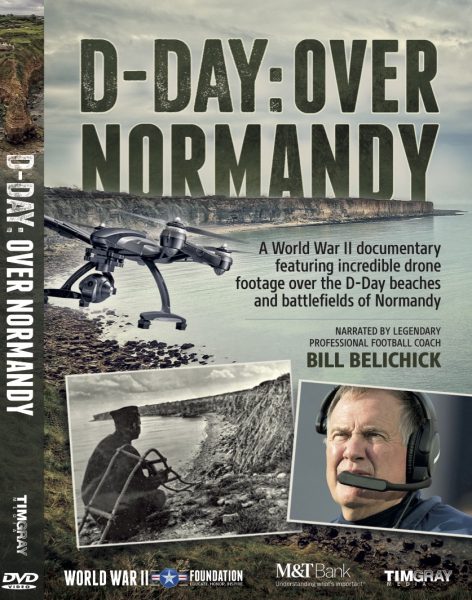
The post Coach Bill Belichick Narrates New Documentary D-Day: Over Normandy appeared first on World War Media.
]]>The post In 2005, a 83 Year-old World War II pilot Saw Footage of His 1944 Spitfire Crash For the First Time appeared first on World War Media.
]]>For the first time ever, WWII pilot John S Blyth sees footage of him crash-landing his Spitfire in 1944.
The post In 2005, a 83 Year-old World War II pilot Saw Footage of His 1944 Spitfire Crash For the First Time appeared first on World War Media.
]]>The post 109 Year Old WWII Veteran and His Secrets to Life appeared first on World War Media.
]]>Meet Richard Overton, possibly America’s oldest veteran. Born on May 11, 1906, he has celebrated 110 birthdays (109 at the time of filming) and counting.
This supercentenarian has lived through the Great Depression, served in World War II, and witnessed the rise of the Internet. From the Ford Model T to self-driving cars, more technological and scientific progress have occurred in Overton’s lifetime than perhaps any other century in history. Overton enlisted in the U.S. military on September 3, 1940 at Fort Sam Houston, Texas. He served in the South Pacific from 1940 through 1945, including stops in Hawaii, Guam, Palau and Iwo Jima. He left the U.S. Army in October 1945 as a corporal, technician fifth grade.
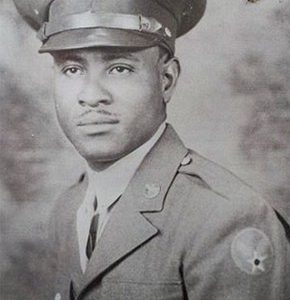
In a short film featured by National Geographic, the Austin, Texas, resident reveals that he sometimes smokes more than 12 cigars a day, and drinks four glasses of whiskey in the morning. “It makes you feel better,” he says. The supercentenarian prescribes to the “Overton diet,” saying, “I eat ice cream every night. It makes me happy.” His favorite flavor is butter pecan. When he’s not in the mood for dessert, Overton also enjoys milk, fish, corn and soup, which is underrated in his opinion.
Richard Overton was even featured in Cigar Aficionado Magazine as America’s oldest cigar smoker. He told the publication that putting a little bourbon in your morning coffee is “like medicine.”
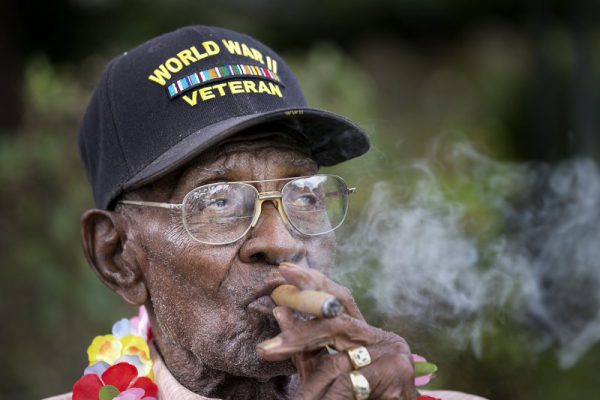
The post 109 Year Old WWII Veteran and His Secrets to Life appeared first on World War Media.
]]>The post Call of Duty: WWII appeared first on World War Media.
]]>Over two years in the making, Sledgehammer Games delivers a gritty, personal experience in the setting of the largest worldwide conflict in history to a new gaming generation in Call of Duty®: WWII.
Play through the story of ordinary men turned soldiers in the 1st Infantry Division as they fight to preserve freedom in the face of tyranny. Call of Duty: WWII delivers fast-paced, boots-on-ground combat through iconic locations in the European Theater.
To stay as close as possible to historical accuracy, Sledgehammer worked closely with noted author and military historian Martin K A Morgan .
Call of Duty: WWII will be released on 3 November 2017 for PS4, Xbox One and PC.
Pre-order Call of Duty: WWII now on-disc or digital download and secure your code for the Private Beta: http://www.CallofDuty.com/WWII
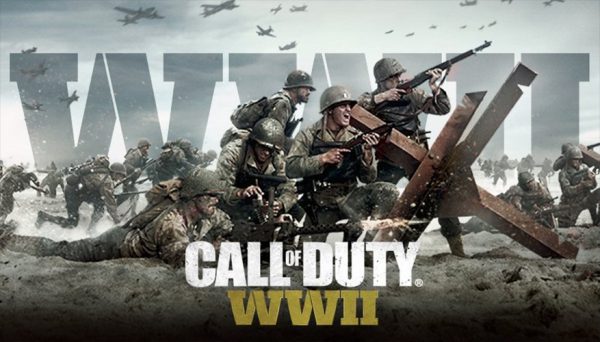
The 1st Infantry Division entered combat in World War II as part of “Operation Torch”, the invasion of North Africa, the first American campaign against the Axis powers. On Nov. 8, 1942, following training in the United Kingdom, men of the First Division landed on the coast of Algeria near Oran. The initial lessons of combat were harsh and many men were casualties in the campaign that followed and which stretched from Algiers into Tunisia. On May 9, 1943, the commander of the German “Afrika Korps” surrendered his force of 40,000 and North African operations for the Big Red One ended. The Division then moved on to take Sicily in “Operation Husky.” It stormed ashore at Gela, July 10, 1943, and quickly overpowered the Italian defenses. Soon after, the Division came face-to-face with 100 tanks of the Herman Goering Tank Division. With the help of naval gunfire, its own artillery and Canadian allies, the First Infantry Division fought its way over the island’s hills, driving the enemy back. The Fighting First advanced on to capture Troina and opened the Allied road to the straits of Messina.
On D-Day, June 6, 1944, the Big Red One stormed ashore at Omaha Beach. Soon after H-Hour, the Division’s 16th Infantry Regiment was fighting for its life on a strip of beach near Coleville-sur-Mer that had been marked the “Easy Red” on battle maps. As the assault progressed, the beach became so congested with destroyed equipment, the dead and the wounded, that there was little room to land reinforcements. Col. George Taylor, commander of the 16th Infantry Regt., told his men, “Two kinds of people are staying on this beach! The dead and those who are going to die! Now, let’s get the hell out of here!” Slowly, spurred by the individual heroism of many individuals, the move inland got underway.
A German blockhouse above the beach became a command post named “Danger Forward.”
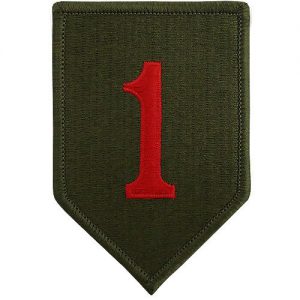
After the beachhead was secured, the Division moved through the Normandy Hedgerows. The Division liberated Liege, Belgium, and pushed to the German border, crossing through the fortified Siegfried line. The 1st Inf. Div. attacked the first major German city, Aachen, and after many days of bitter house-to house fighting, the German commander surrendered the city on Oct. 21, 1944.
The Division continued its push into Germany, crossing the Rhine River. On Dec. 16, 24 enemy divisions, 10 of which were armored, launched a massive counterattack in the Ardennes sector, resulting in what became known as the Battle of the Bulge. The Big Red One held the critical shoulder of the “Bulge” at Bullingen, destroying hundreds of German tanks in the process. On Jan. 15, 1945, the First Infantry attacked and penetrated the Siegfried line for the second time and occupied the Remagen bridgehead. On Easter Sunday, April 1, 1945, the Division marched 150 miles to the east of Siegen. On April 8, the Division crossed the Weser River into Czechoslovakia. The war was over May 8, 1945.
At the end of World War II, the Division had suffered 21,023 casualties and 43,743 men had served in its ranks. Its soldiers had won a total of 20,752 medals and awards, including 16 Congressional Medals of Honor. Over 100,000 prisoners had been taken.
Following the war, the First Division remained in Germany as occupation troops, until 1955, when the Division moved to Fort Riley, Kan. (Source)
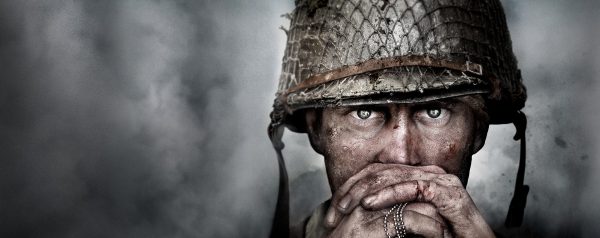
The post Call of Duty: WWII appeared first on World War Media.
]]>The post Joseph Stalin III Heavy Tank Running at the Bastogne Barracks appeared first on World War Media.
]]>On a regular basis, several volunteers of the Vehicle Restoration Center at the barracks in Bastogne demonstrate their passion for military history and engineering. Two large Exhibition Halls are open to the public showing its enormous collection of WWII vehicles. Here, a IS III (Joseph Stalin III) Heavy Sovjet Tank circles around the workshop.
There are two tanks known as IS-3:
Object 244 was an IS-2 rearmed with the long-barrelled 85mm cannon (D-5T-85-BM) and developed by LKZ (in Leningrad), which was never series-produced for service use.
Object 703 was developed in late 1944 by ChTZ (in Chelyabinsk) and left the factory shop in May 1945. This tank had an improved armour layout, and a semi-hemispherical cast turret which became the hallmark of post-war Soviet tanks. While this low, hemispherical turret improved protection, it also significantly diminished the headroom, especially for the loader. The low turret also limited the maximum depression of the main 122 mm gun, since the gun breech had little room inside the turret to elevate, and this limited the extent to which the IS-3 could take advantage of hull-down positions compared to higher Western tanks. The IS-3’s pointed prow earned it the nickname Shchuka (Pike) by its crews. It weighed slightly less and stood 30 centimetres (12 in) lower than previous versions. Wartime production resulted in many mechanical problems and a hull weldline that had a tendency to crack open.
The IS-3 came too late to see action in World War II. The first public demonstration of the IS-3 came on 7 September 1945 during the Allied victory parade on Charlottenburger Straße in Berlin, with the heavily reinforced 71st Guards Heavy Tank Regiment of the 2nd Guards Tank Army. Source
The post Joseph Stalin III Heavy Tank Running at the Bastogne Barracks appeared first on World War Media.
]]>The post Original footage of US Troops storming at the Normandy Beaches on D-Day appeared first on World War Media.
]]>To secure the Normandy beachheads on June 6, 1944, US troops had to frontally attack the beach in order to silence the enemy guns.
This original footage, filmed on D-Day shows the greatest heroes of the 20th century .
The post Original footage of US Troops storming at the Normandy Beaches on D-Day appeared first on World War Media.
]]>The post In Memory of DEAR MOM appeared first on World War Media.
]]>In special Memory of the B-17F Crew, 94 Bomber Group, 331 Bomber Squadron 42-30389.
Aug. 17, 1943. A massive formation of B-17s thundered toward Germany on a mission to bomb the Messerschmitt aircraft factory at Regensburg. For the U.S. Army Air Forces, the day would end in disaster. Of the 146 Eighth Air Force bombers on the raid, German anti-aircraft guns and fighters shot 24 out of the sky and badly damaged at least 50 others.
The first plane to fall was Dear Mom, with Staff Sgt. James W. Tolbert of the North Side aboard as tailgunner. The 19-year-old was lucky. After the front of the plane exploded, knocking him out and breaking his nose and jaw, he regained consciousness in time to parachute out. The German fighter that shot up his plane swept in on him as he descended, but the pilot dipped his plane’s wings in a show of respect and let him live. Six of Staff Sgt. Tolbert’s nine crewmates died either in the initial explosion or when the plane hit the ground.
Staff Sgt. Tolbert was taken in by villagers in the town of Lummen, Belgium, but German soldiers soon captured him. He spent the rest of the war as a POW along with the radio operator, Arthur McDonnell of Massachusetts. Two other survivors — waist gunners Beverly Geyer of Texas and Jacob Dalinsky of Pennsylvania — escaped to North Africa with the help of the Belgian resistance.
The fate of Dear Mom is just a footnote in the grim annals of World War II, but it will always be remembered in Lummen, Belgium.
Staff Sgt. Tolbert died in 1997 after spending his life working as a boilermaker in Pittsburgh’s mills and raising 12 children in Emsworth with his wife. One of his sons, John Tolbert, 57, a real estate appraiser in Connecticut and a former history teacher, made the trip to Lummen in 2013 to pay tribute to his dad. “I wanted to represent him and our family,” he said .”I feel that this is something he deserves and I would love to be there in person.” ‘He didn’t really talk about a lot of things’
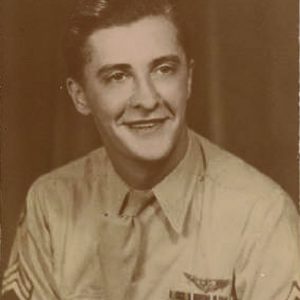
SSgt James Tolbert
Growing up in Emsworth, John Tolbert managed to get his father to open up about the war only now and then, and never did learn many details. “He had a hard life,” he said. “He didn’t really talk about a lot of things.”
The Belgian monument was a bit of a mystery to him, too. But it all became clear at the ceremony, attended by the local mayor and other dignitaries, an American embassy official and an honor guard. As soon as he learned about the project from Rudi Kenis, John Tolbert knew he wanted to go there. The Belgians had taken it upon themselves to build the monument as a show of appreciation for Americans who helped liberate Belgium from the German war machine.
In 2003, Mr. Tolbert had stopped at Lummen while on a European vacation with his wife. One of the locals showed them where the B-17 had crashed, but there was no marker of any kind. As they were leaving, Mr. Tolbert commented that there should be one. A retired teacher from Lummen named Rudy Kenis, who has been researching wartime air crashes in Belgium for 40 years, thought so, too. He had the idea for a monument two decades ago but said no one else was interested. But he persisted, and the effort gained steam. The work started in July 2013 when Mr. Kenis’ cousin, Nico Cypers, found someone to build the monument. A newspaper reporter, Koen Luts, and a local historian, Reg Jans, helped in organizing the ceremony. In trying to find relatives, Mr. Kenis came across a website dedicated to the Tolbert family and contacted John Tolbert to tell him about the project.
“May this monument keep the memory alive and pay tribute to all the great men who paid the highest price for our freedom, those who came back and those who never returned,” Mr. Kenis said on a Facebook page dedicated to the monument. “Lest we forget.”
Over the years, Mr. Kenis said he had heard so many stories about air crews and crashes during the war that he felt obligated to do something for those lost. “They are all heroes we may never forget,” he said by email last week. “I was impressed when I saw thousands of graves here in Belgium from those who died. And all those men did this to give us our freedom back!”
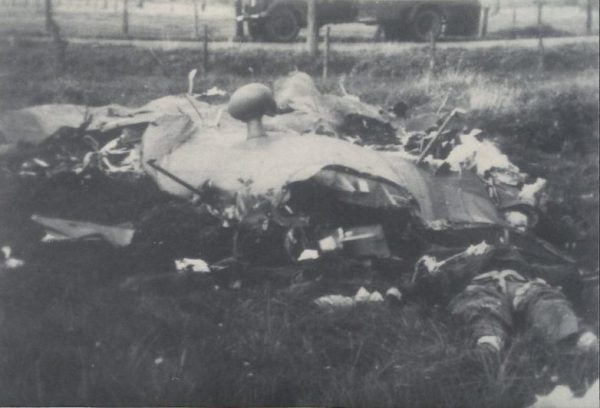
Orphan at 14, soldier after high school
The World War II generation is dwindling, and soon the war will exist only in memory and archive. James Tolbert was like so many Americans who came of age in those years — toughened by the Depression and tempered by war. He knew hardship early on.
By the time he was 14, both of his parents were dead and his sister, Clara, became his caretaker on Success Street. He graduated from Oliver High School and enlisted in 1942, training in Texas as a gunner before shipping overseas in 1943.
He had flown about a dozen missions by the time of the Regensburg raid, according to correspondence from his sister. The bombers, part of the 94th Bomb Group, took off at 6 a.m. from Bury St. Edmunds in England and encountered heavy flak from anti-aircraft guns soon after crossing over the Belgian coast.
In an after-action report, Staff Sgt. Geyer said the crew was expecting P-47 escorts. But they never showed up. What he thought was a formation of escorts turned out to be a swarm of German Focke-Wulf 190s. One of them, piloted by the famed German ace Karl Borris, opened fire with its 20mm cannon, striking Dear Mom’s oil tanks. Staff Sgt. Geyer said he saw oil and pieces of the wing fly past him as the plane flipped to one side and started to go down. The pilot, Bernard Nayovitz, ordered everyone to bail. As the men scrambled for their chutes, the front of the plane exploded and the fuselage broke in half. Six of the crew in the front of the plane were killed — Lt. Nayovitz of New York; co-pilot James Smith of Alabama; navigator Murlyn Burnett of Oklahoma; bombardier Robert Allison of Pennsylvania; top gunner Albert Beyke of Ohio; and ball turret gunner Jack Loveless of Washington, D.C. The other four bailed out, although none saw what happened to Staff Sgt. Tolbert.
As he descended in his chute, an FW190 approached. Staff Sgt. Tolbert thought he was going to be machine-gunned. “A fighter made a turn for me as I was hanging in my chute, and flew by me and dipped his wings,” he told his sister. “The dip is a sign of respect, or a salute.” When Staff Sgt. Tolbert landed, his face bloody and his ankle injured, the villagers picked him up and carried him to a nearby tavern. Because of the blood, they thought he was going to die and summoned a priest in addition to a doctor. German soldiers soon arrived and took him into custody, loading him onto a hay wagon with Arthur McDonnell. Both were taken to a hospital about 10 miles away. While there, the German fighter pilot who had dipped his wings came to visit. It was almost certainly Karl Borris, who by the end of the war would shoot down five B-17s and 28 Spitfires, but records aren’t clear. At any rate, the officer saluted him and shook his hand. “Were it not for the war,” he said, “perhaps you and I could have been friends.”
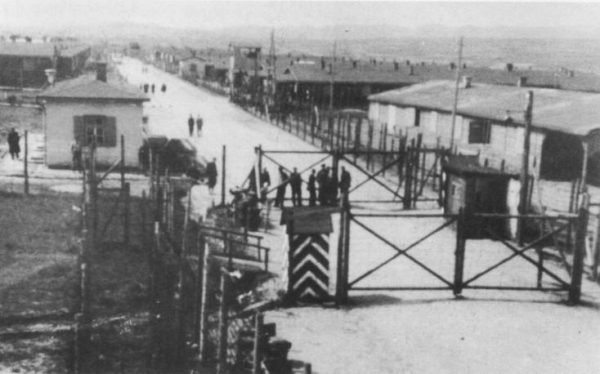
Stalag XVII B
Two years in Stalag 17
John Tolbert said his dad told him that story once when they were watching a simplistic Hollywood war movie that portrayed all the Germans as evil Nazis.
“He tried to teach me that wasn’t true,” he said.
Staff Sgt. Tolbert said he was also treated well at Stalag 17, the Austrian POW camp where he was held captive and where one of the friendly guards showed him pictures of his own family. Staff Sgt. Tolbert spent nearly two years in that camp, which later became the subject of a popular 1953 movie.
After the war, Staff Sgt. Tolbert came home and got on with his life, like millions of other vets, and rarely talked about any of what he’d seen.
It’s a pattern repeated again and again among combat veterans of the big war. “I feel that he never wanted recognition,” said John Tolbert. “He may also have felt a sense of guilt” that he survived and others didn’t. “He used to shrug his shoulders and say the only heroes he knew were the ones who didn’t come home.”
Source: Rudy Kenis & Pittsburg Post Gazette/Torsten Ove
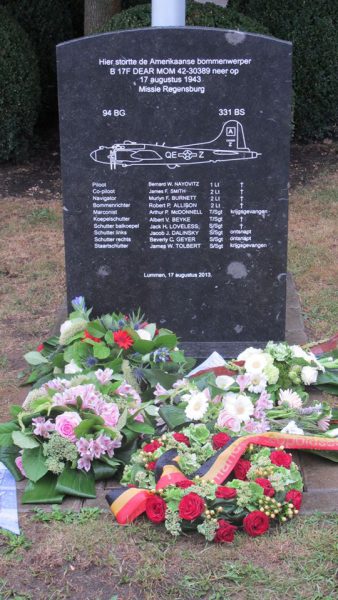
The post In Memory of DEAR MOM appeared first on World War Media.
]]>The post Shooting a Vickers Machine Gun at 240 frames per second appeared first on World War Media.
]]>The Vickers machine gun has what is perhaps the greatest reputation among recoil operated belt-fed water-cooled machine guns. Adopted by the U.K. in 1912, it proved itself in the crucible of World War I trench warfare a superlative of ruggedness and reliability.
By Martin K.A. Morgan
In one notable example from the Battle of the Somme, the 100th Machine Gun Company was assigned the task of delivering a 12-hour barrage of sustained fire against German trenches 2,000 yards away. Ten Vickers machine guns were put to the task, and they opened fire during the afternoon of August 23, 1916. When the guns ceased fire the next day, they had expended just under one million rounds of .303 ammunition.
Each Vickers had ripped through almost 100,000 rounds with only occasional interruptions to change barrels. The fact that each of these 10 guns could sustain such an incredibly high volume of fire clearly indicated the asthonishing engineering strength of the Vickers machine gun system – a system that would serve U.K. forces for over five decades. Only a small fraternity of military firearms enjoys unquestioned esteem and admiration the way that the Vickers does. It carved its name into the military history of the 20th Century through decades of reliable service, and it continues to reaffirm its prodigious reputation here in the 21st Century.
During a recent day of shooting in southern Louisiana a 100 year old Vickers that was made at the Crayford Works just east of London was put to work firing brand new .303 ammunition made in Serbia by Prvi Partizan. Although it was not asked to fire 100,000 rounds in 12 hours, it nevertheless turned-in a predictably flawless performance, the proof of which can be seen in this video.
The post Shooting a Vickers Machine Gun at 240 frames per second appeared first on World War Media.
]]>The post Lt Col Robert G Cole in Carentan- Normandy (Part II) appeared first on World War Media.
]]>Lt Col. Cole parachuted into Normandy with his unit (Third Battalion of the 502 Parachute Infantry Regiment, 101 Airborne Division) in Normandy. By the evening of June 6, he had gathered 75 men. They captured Exit 3 at Saint-Martin-de-Varreville behind Utah Beach and were at the dune line to welcome men from the U.S. 4th Infantry Division coming ashore. After being in division reserve, Cole’s battalion had guarded the right flank of the 101st Airborne Division attempts to take the approaches to Carentan.
On the afternoon of June 10, Cole led 400 men of his battalion single file down a long, exposed causeway now knpwn as Purple Heart Lane, with marshes at either side. A hedgerow behind a large farmhouse (Ignouf Farm) on the right was occupied by well dug-in German troops. At the far end of the causeway was the last of four bridges over the Douve River flood plain. Beyond the last bridge was Carentan, which the 101st had been ordered to seize to effect a linkup with the 29th Infantry Division coming off Omaha Beach.
During the advance Cole’s battalion was subjected to continuous fire from artillery, machine guns and mortars. Cole’s battalion, advancing slowly by crawling or crouching, took numerous casualties. The survivors huddled against the bank on the far side of the causeway. An obstacle known as a Belgian gate blocked nearly the entire roadway over the last bridge, allowing the passage of only one man at a time. Attempts to force this bottleneck were futile, and the battalion took up defensive positions for the night.
During the night, Cole’s men were exposed to shelling by German mortars and by a strafing and bombing attack by two aircraft, causing further casualties and knocking Company I out of the fight. However the fire from the farm slackened and the remaining 265 men infiltrated through the obstacle and took up positions for an assault.
With the Germans still resisting any attempt to move beyond the bridges, and after artillery failed to suppress their fire, Cole called for smoke on the dug-in Germans and ordered a bayonet charge, a rarity in World War II. He charged toward the hedgerow, leading only a small portion of his unit at first. The remainder of the battalion, seeing what was happening followed as Cole led the paratroopers into the hedgerows, engaging at close range and with bayonets in hand-to-hand combat. The German survivors retreated, taking more casualties as they ran away.
Lt Col Cole was killed in action on 18 September 1944 during the first day of Operation Market Garden near the Dutch town of Best. Posthumously, Cole was awarded with the Medal of Honor.
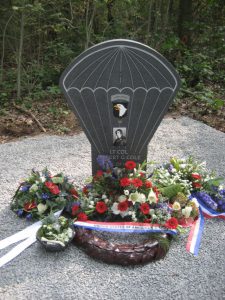 [read more=”Click here to Read More” less=”Read Less”]
[read more=”Click here to Read More” less=”Read Less”]
Citation:
For gallantry and intrepidity at the risk of his own life, above and beyond the call of duty on 11 June 1944, in France. Lt. Col. Cole was personally leading his battalion in forcing the last 4 bridges on the road to Carentan when his entire unit was suddenly pinned to the ground by intense and withering enemy rifle, machinegun, mortar, and artillery fire placed upon them from well-prepared and heavily fortified positions within 150 yards of the foremost elements. After the devastating and unceasing enemy fire had for over 1 hour prevented any move and inflicted numerous casualties, Lt. Col. Cole, observing this almost hopeless situation, courageously issued orders to assault the enemy positions with fixed bayonets. With utter disregard for his own safety and completely ignoring the enemy fire, he rose to his feet in front of his battalion and with drawn pistol shouted to his men to follow him in the assault. Catching up a fallen man’s rifle and bayonet, he charged on and led the remnants of his battalion across the bullet-swept open ground and into the enemy position. His heroic and valiant action in so inspiring his men resulted in the complete establishment of our bridgehead across the Douve River. The cool fearlessness, personal bravery, and outstanding leadership displayed by Lieutenant Colonel Cole reflect great credit upon himself and are worthy of the highest praise in the military service
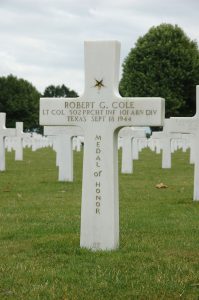
The post Lt Col Robert G Cole in Carentan- Normandy (Part II) appeared first on World War Media.
]]>The post The Massacre at The Aid Station appeared first on World War Media.
]]>The story of George Vanderslice and Merle Lauer, two airborne medics, and their experiences at the Aid Station in Foy, Bastogne, during the Battle of the Bulge.
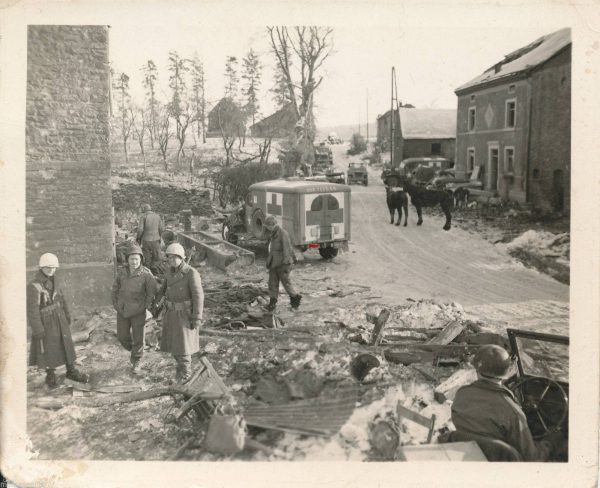
Foy- Bastogne. Photo taken on 14 January 1945
The post The Massacre at The Aid Station appeared first on World War Media.
]]>The post The Belt That Saved a Life appeared first on World War Media.
]]>The story of Art Petersen and Henry Beck; two hungry paratroopers at Bastogne during the Battle of the Bulge.
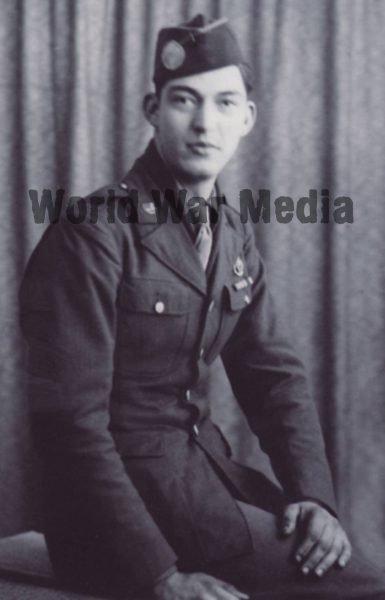
Art Petersen F Co 506 PIR- 101 Airborne Division
The post The Belt That Saved a Life appeared first on World War Media.
]]>The post The Shell That Didn’t Explode appeared first on World War Media.
]]>Battlefield Historian Reg Jans talks about an Armor Piercing Round hitting a civilian shelter in the basement of the Koeuhne House at Foy during the siege of Bastogne.
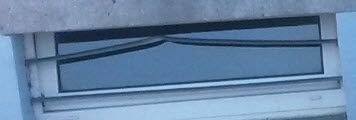
The post The Shell That Didn’t Explode appeared first on World War Media.
]]>The post Band of Brothers: Captain Ronald Speirs’ Run in Foy, Bastogne appeared first on World War Media.
]]>Battlefield Historian Reg Jans talks about Cpt Ronald Speirs’ incredible run in Foy, Bastogne.
The post Band of Brothers: Captain Ronald Speirs’ Run in Foy, Bastogne appeared first on World War Media.
]]>The post Breathtaking Drone Footage from the American Military Cemetery of Henri-Chapelle, Belgium appeared first on World War Media.
]]>At the Henri-Chapelle American Cemetery and Memorial in Belgium, covering 57 acres, rest 7,992 soldiers, most of whom lost their lives during the advance of the U.S. armed forces into Germany. Their headstones are arranged in gentle arcs sweeping across a broad green lawn that slopes gently downhill. A highway passes through the cemetery. West of the highway is an overlook that affords an excellent view of the rolling Belgian countryside, once a battlefield.
To the east is the long colonnade that, with the chapel and map room, forms the memorial overlooking the burial area. The chapel is simple, but richly ornamented. In the map room are two maps of military operations, carved in black granite, with inscriptions recalling the achievements of our forces. On the rectangular piers of the colonnade are inscribed the names of 450 missing. Rosettes mark the names of those since recovered and identified. The seals of the states and territories are also carved on these piers.
The cemetery possesses great military historic significance as it holds fallen Americans of two major efforts, one covering the U.S. First Army’s drive in September 1944 through northern France, Belgium, Holland and Luxembourg into Germany, and the second covering the Battle of the Bulge. It was from the temporary cemetery at Henri-Chapelle that the first shipments of remains of American war dead were returned to the United States for permanent burial. The repatriation program began on July 27, 1947 at a special ceremony at the cemetery when the disinterment began. The first shipment of 5,600 American war dead from Henri-Chapelle left Antwerp, Belgium the first week of October 1947. An impressive ceremony was held, with over 30,000 Belgian citizens attending, along with representatives of the Belgium government and senior Americans.
The cemetery is open daily to the public from 9 a.m. to 5 p.m., except December 25 and January 1. It is open on host country holidays. During operating hours, a staff member is on duty in the visitor building to answer questions and escort relatives.
Contact ABMC at Henri-Chapelle
Video produced and directed by Robby Prinsen. All rights reserved.
The post Breathtaking Drone Footage from the American Military Cemetery of Henri-Chapelle, Belgium appeared first on World War Media.
]]>The post Shooting an MG42 at Regular Speed and 240 Frames per Second! appeared first on World War Media.
]]>The MG42 is perhaps one of the most infamous weapons of war ever created, mainly because the intimidating qualities of its high cyclic rate of fire. The German military made effective use of it during the closing years of the Second World War and, although the cartridge it fires – 7.92×57mm Mauser – is no longer in widespread military use, the MG42’s roller-locked recoil operation influenced designs that remain in military service today. Since a variety of reliable sources on the internet provide deep and factual examinations of the history and development of the MG42, this short article will deal with another part of the weapon’s history.
By Martin K.A. Morgan
Thousands of MG42s are legally owned in the United States by collectors who purchased them in compliance with the regulations spelled out by the National Firearms Act of 1934. This law provides a heavily regulated category of civilian ownership of machine guns, suppressors, short-barreled rifles and short-barreled shotguns which requires fingerprints, a background check, and registration. Eligible U.S. citizens over the age of 21 with no criminal arrest record pay a one-time $200 transfer tax and wait up to 15 months before being able to take ownership of a legally registered firearm like an MG42. Making things even more complicated, keeping an MG42 running in the 21st Century is no longer easily affordable. This is because of not just the sales price of the gun itself, but also the price of the ammunition. It used to be that, three or four decades ago, feeding a 42 was not a particularly costly prospect, but things are much different today. Most of the surplus ammunition that used to make shooting much more affordable is no longer available, leaving factory new ammunition as the most reliable option for a day at the range. The eighty-nine year old Serbian ammunition maker Prvi Partizan (aka PPU) produces a 198g full metal jacketed 7.92x57mm cartridge that makes the MG42 run like the day it was made.
On a recent, unseasonably cold Sunday afternoon in rural Louisiana, an MG42 made by Maschinenbau und Gerätebau GmbH, Berlin-Tegel (also known as MAGET) in 1943 was put through the paces with several hundred rounds of PPU ammunition. This video shows just how efficiently that ammunition makes the 42 do what it was designed to do. No malfunctions were encountered at any point and, because the outside temperature was below 32° Fahrenheit/0° Celsius, the weapon did not build-up heat rapidly as MG42s are prone to do in warmer weather. While reading about “Hitler’s Buzz Saw” in abstract is informative, being able to shoot one and then review footage of it in operation provides an irreplaceable lesson in World War II history.
Private ownership is the only outlet for experiencing this rare insight into the realities of combat against the Third Reich, and it is only because individuals who have the interest and the resources, that a video like this can exist. Otherwise, we would only have the occasional training film and the personal accounts of men who faced this very dangerous weapon in action. As veterans recede from the living memory of World War II, it is up to a post-veteran generation to preserve the war’s history and promote a better understanding of the conflict that gave birth to the MG42.
The post Shooting an MG42 at Regular Speed and 240 Frames per Second! appeared first on World War Media.
]]>The post Actor Gary Sinise and the Lt Dan Band appeared first on World War Media.
]]>Band History
In 1997, Gary Sinise and his pal and fellow Steppenwolf Theatre co founder Terry Kinney decided to do a production of Tennessee Williams A Streetcar Named Desire at Steppenwolf in Chicago. Sinise would play Stanley Kowalski and Kinney would direct. Kinney hired Chicago composer Kimo Williams to write the music and it was during the technical rehearsals for the play that Gary and Kimo began to discuss their love for music. Learning of Gary’s talents on the bass, Kimo invited him to his home for a jam session. Over the next few years, whenever possible, the two would play together with other Chicago area musicians and in 2003, as Gary began what has turned out to be an extraordinary commitment to the USO, it became clear that those early jam sessions had laid the foundation for what would become The Lieutenant Dan Band.
In 2003, following one of his many trips overseas to visit those serving our country that year, Gary asked the USO if they would allow him to take a band with him on a tour. He wanted to entertain in the spirit of the Bob Hope tours in years past. As he had already gone on several handshake tours, the USO agreed. The band was pulled together, began rehearsing, and in February of 2004, Gary Sinise and The Lieutenant Dan Band hit the road on their first overseas USO tour to Korea, Singapore and Diego Garcia. From those early sessions at Kimo’s house, a few gigs for the troops in the Chicago area in 2003, and that first overseas tour, Gary and the band have played an average of 30-40 shows per year with a good 95% of those shows for USO, military charities, resiliency events or benefits. Over 300 shows since its founding.
After forming his own military charity, Gary Sinise Foundation, the band was folded into GSF as a program of the foundation and continues its primary mission of support for military and veterans through Honor, Gratitude, Rock and Roll.
The Name
“Lieutenant Dan” is the character Gary portrayed in the 1994 film Forrest Gump, a role for which he earned an Oscar nomination for Best Supporting Actor. As Gary began visiting troops around the world, people (even little kids) who didn’t know him as Gary Sinise, the actor, would recognize him as “Lt.Dan”. Those in the miliary also seem to identify strongly with the character. And so the name for his group was an easy choice:
Gary Sinise and The Lt. Dan Band!
The Music
The band covers everything from classics by Stevie Wonder, Journey, Bruce Springsteen, and The Police to contemporary songs by Bruno Mars, The Band Perry, Sara Bareilles, Dave Matthews Band, Beyoncé, the Zac Brown Band and much much more. Pop, Rock, Blues, Motown, Soul, Country, even tunes from the 40’s big band era. There’s something for everyone and each show highlights the musical diversity of the band, as well as the passion and energy each member brings to the stage. Whether performing for troops overseas or at a local club, the goal is to have fun and rock the house!
The post Actor Gary Sinise and the Lt Dan Band appeared first on World War Media.
]]>The post Howard Snyder, Pilot of the B-17 ‘Susan Ruth’ appeared first on World War Media.
]]>Howard Snyder, pilot of the B-17 Susan Ruth, tells what happened to him and his crew after his bomber was shot down over Belgium on February 8, 1944.
The interview took place during the 2004 Air Forces Escape & Evasion Society Reunion in King of Prussia, Pennsylvania, USA.
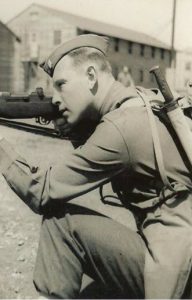
The story of Howard Snyder and his crew was very well documented by his son Steve Snyder
The post Howard Snyder, Pilot of the B-17 ‘Susan Ruth’ appeared first on World War Media.
]]>The post A Soldier’s Memoir-PTSD appeared first on World War Media.
]]>Vetted and approved by The US Military Armed Forces Entertainment Program, Joe Bachman & his band have performed hundreds of shows around the country in support of our Active Duty and Veterans. His original ballad, “A Soldier’s Memoir (PTSD Song)” is well over 1 MILLION Views on YouTube and is currently being used in therapy sessions with our returning Vets around the US. As the son of an Army Soldier, Bachman holds the US Military very near and dear to his heart.
Written by: Mitch Rossell & Joe Bachman
Lyrics
I’ve been home about six months now
And I still have my doubts
I’m not sure how I got here
Or how I’m gonna get out
My Mama says I look the same
As I did before I left
But if she could see inside of me
It would scare her to death
I can still taste the powder
From the barrel of my gun
I can hear my Sergeant screaming,
“Run, Soldier, run.”
I can feel the backpack on my shoulders
God, it weighed a ton
I see death in every single thought
They taught me how to put that uniform on
I just can’t get it off
Last Saturday they honored us
In a small parade downtown
When they shot off those fireworks
I nearly hit the ground
While they smiled and cheered for us
All I could do was stare
Cuz part of me is here at home
And part of me’s back there
I can still taste the powder
From the barrel of my gun
I can hear my Sergeant screaming,
“Run, Soldier, run.”
I can feel the backpack on my shoulders
God, it weighed a ton
I see death in every single thought
They taught me how to put that uniform on
I just can’t get it off
Yeah there’s no end in sight
Cuz even though I’m home now
I’m still fighting for my life
I can still taste the powder
From the barrel of my gun
I can hear my Sergeant screaming,
“Run, Soldier, run.”
I can feel the backpack on my shoulders
God, it weighed a ton
I see death in every single thought
They taught me how to put that uniform on
I just can’t get it off
The post A Soldier’s Memoir-PTSD appeared first on World War Media.
]]>









